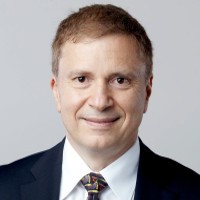DESCRIPTION
Realistic computer simulation of the human body — not just the bones, joints, and muscles, but also the sensory organs and, of course, the brain — is a grand scientific challenge in the quest for artificial intelligence/life. In this context, I will present our advances in biomimetic human simulation and sensorimotor control. Our framework features an unprecedentedly detailed biomechanical human musculoskeletal model actuated by more than 800 muscles, with functional eyes whose retinas have numerous nonuniformly-distributed photoreceptors. This bio-inspired perceptual apparatus feeds the sensorimotor center of our virtual human’s brain, which currently incorporates two dozen (deep) neural networks, organized as a neurovisual sensory subsystem that drives a neuromuscular motor subsystem. Synthesizing its own motor and visual training data, our autonomous virtual human learns efficient and robust active visuomotor control of its eyes, head, torso, and limbs to perform a variety of nontrivial sensorimotor tasks never previously achieved in realistic biomechanical human simulations or anthropomimetic robotics.
DETAILS
Course type: Invited lecture (in person delivery)
Duration: 1 hour
Level: all
Institution of lecturer: University of California, Los Angeles, USA
LECTURER
Prof. Demetri Terzopoulos
 Demetri Terzopoulos is Distinguished Professor and Chancellor’s Professor of Computer Science at the University of California, Los Angeles, where he directs the UCLA Computer Graphics & Vision Laboratory. He is also Co-Founder and Chief Scientist of VoxelCloud, Inc., a multinational healthcare AI company. He graduated from McGill University, received his PhD degree (’84) in Artificial Intelligence from the Massachusetts Institute of Technology (MIT), and remained as a Research Scientist at the MIT Artificial Intelligence Laboratory through 1985. He is or was a Guggenheim Fellow, a Fellow of the ACM, a Life Fellow of the IEEE, a Distinguished Fellow of the IETI, a Fellow of the Royal Society of London and the Royal Society of Canada, a Fellow of the Canadian Academy of Engineering, a Member of the European Academy of Sciences and the New York Academy of Sciences, and a Life Member of Sigma Xi. His many awards include an Academy Award for Technical Achievement from the Academy of Motion Picture Arts and Sciences for his pioneering work on physics-based computer animation, in addition to the IEEE’s Computer Pioneer Award, Helmholtz Prize, inaugural Marr Prize citation, and inaugural Computer Vision Distinguished Researcher Award for his pioneering and sustained research on deformable models and their applications. Deformable models, a term he coined, is listed in the IEEE Taxonomy. With his nearly 500 published research papers and several volumes, primarily in computer graphics, computer vision, medical imaging, computer-aided design, and artificial intelligence/life, the ISI and other indexes have listed him among the most highly-cited authors in engineering and computer science. He has given more than 500 invited talks worldwide about his research, including over 150 distinguished lectures and plenary/keynote addresses. He joined UCLA in 2005 from New York University, where he held the Henry and Lucy Moses Endowed Professorship in Science and was Professor of Computer Science and Mathematics at NYU’s Courant Institute of Mathematical Sciences. Previously, he was Professor of Computer Science and Professor of Electrical & Computer Engineering at the University of Toronto. Prior to becoming an academic in 1989, he was a Program Leader at Schlumberger corporate research centers in Palo Alto, California, and Austin, Texas.
Demetri Terzopoulos is Distinguished Professor and Chancellor’s Professor of Computer Science at the University of California, Los Angeles, where he directs the UCLA Computer Graphics & Vision Laboratory. He is also Co-Founder and Chief Scientist of VoxelCloud, Inc., a multinational healthcare AI company. He graduated from McGill University, received his PhD degree (’84) in Artificial Intelligence from the Massachusetts Institute of Technology (MIT), and remained as a Research Scientist at the MIT Artificial Intelligence Laboratory through 1985. He is or was a Guggenheim Fellow, a Fellow of the ACM, a Life Fellow of the IEEE, a Distinguished Fellow of the IETI, a Fellow of the Royal Society of London and the Royal Society of Canada, a Fellow of the Canadian Academy of Engineering, a Member of the European Academy of Sciences and the New York Academy of Sciences, and a Life Member of Sigma Xi. His many awards include an Academy Award for Technical Achievement from the Academy of Motion Picture Arts and Sciences for his pioneering work on physics-based computer animation, in addition to the IEEE’s Computer Pioneer Award, Helmholtz Prize, inaugural Marr Prize citation, and inaugural Computer Vision Distinguished Researcher Award for his pioneering and sustained research on deformable models and their applications. Deformable models, a term he coined, is listed in the IEEE Taxonomy. With his nearly 500 published research papers and several volumes, primarily in computer graphics, computer vision, medical imaging, computer-aided design, and artificial intelligence/life, the ISI and other indexes have listed him among the most highly-cited authors in engineering and computer science. He has given more than 500 invited talks worldwide about his research, including over 150 distinguished lectures and plenary/keynote addresses. He joined UCLA in 2005 from New York University, where he held the Henry and Lucy Moses Endowed Professorship in Science and was Professor of Computer Science and Mathematics at NYU’s Courant Institute of Mathematical Sciences. Previously, he was Professor of Computer Science and Professor of Electrical & Computer Engineering at the University of Toronto. Prior to becoming an academic in 1989, he was a Program Leader at Schlumberger corporate research centers in Palo Alto, California, and Austin, Texas.
